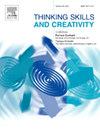幼儿园的创造力是什么样的?学龄前儿童创造力统一性与多样性的多方法研究
IF 4.5
2区 教育学
Q1 Social Sciences
引用次数: 0
摘要
创造力是一个多方面的结构,以各种形式表现出来。虽然之前的研究表明,在学龄儿童和成人中,创造力是一种多样化的技能,但对学龄前儿童的创造力知之甚少。本研究旨在确定学龄前儿童(N = 83,年龄4.40岁)的创造力结构。我们研究了三种基于表现的创造力测量和一种父母报告的创造力测量之间的联系。双变量分析和验证性因子分析(CFA)的发现揭示了创造力任务与父母报告项目之间的实质性关联和非实质性关联。结果提供了初步的证据,表明基于绩效的评估存在多样性,而家长报告的学前创造力测量存在统一性。研究结果还显示,基于表现和父母报告的学前创造力测量之间存在不一致的联系,这表明这些测量方法捕捉了学龄前儿童创造力的不同方面。这些结果揭示了创造力的多维结构,创造力行为测量的有效性,并有助于幼儿创造力的概念化和评估。本文章由计算机程序翻译,如有差异,请以英文原文为准。
What does creativity look like in preschool? A multi-method examination of unity and diversity in preschoolers’ creativity
Creativity is a multifaceted construct that manifests itself in a variety of modalities. While previous research suggests that creativity is a diversified skill in school-aged children and adults, little is known about preschoolers’ creativity. This study aims to identify the structure of creativity in a sample of preschoolers (N = 83, Mage 4.40 years). We examined associations between three performance-based creativity measures and one parent-report measure of creativity. Findings from bivariate analysis and confirmatory factor analysis (CFA) revealed substantive associations within and non-substantive associations between creativity tasks and parent-report items. Results provide preliminary evidence of diversity in performance-based assessments and unity in parent-report measures of preschool creativity. Results also showed inconsistent associations between performance-based and parent-report measures of creativity in preschool, suggesting measures are capturing different facets of preschoolers' creativity. These results shed light on the multidimensional structure of creativity, the validity of behavioural measures of creativity, and contribute to the conceptualization and assessment of creativity in early childhood.
求助全文
通过发布文献求助,成功后即可免费获取论文全文。
去求助
来源期刊

Thinking Skills and Creativity
EDUCATION & EDUCATIONAL RESEARCH-
CiteScore
6.40
自引率
16.20%
发文量
172
审稿时长
76 days
期刊介绍:
Thinking Skills and Creativity is a new journal providing a peer-reviewed forum for communication and debate for the community of researchers interested in teaching for thinking and creativity. Papers may represent a variety of theoretical perspectives and methodological approaches and may relate to any age level in a diversity of settings: formal and informal, education and work-based.
 求助内容:
求助内容: 应助结果提醒方式:
应助结果提醒方式:


